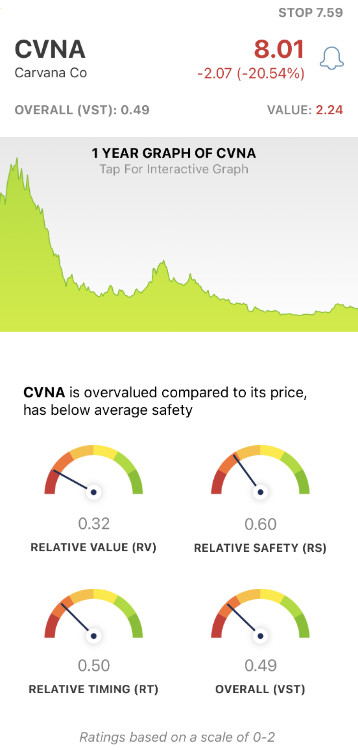Carvana (CVNA) reported fourth-quarter and full-year 2022 results on Friday. Shares fell more than 21% after the announcement. In its annual report, the company registered a more profound deficit for 2022 and an overall decrease of 3% in vehicles sold to customers compared to 2021. Furthermore, the integration of Adesa’s car auction business adversely impacted their 4th quarter and full-year results.
Carvana’s Q4 Results came at a stressful time for the stock market, with stocks closing lower on Friday and the three major U.S. indexes logging their most significant weekly declines of the year. Following the report that a major inflation measure had increased in January, markets experienced a turbulent period of losses. However, despite the negative sentiment and overall market conditions, Carvana’s financial reporting is the most significant reason the stock price dropped.
Carvana has several problems to overcome if it wants to return to profitability. The company is currently dealing with its mounting debt coming due, with bond interest due May 1st surpassing $230 million. Furthermore, Carvana’s retail unit sales were the lowest they have been in two years, and it is expected that the number of vehicles sold for the first quarter of 2023 will show further declines. With a $7.61-a-share loss, the used car retailer is expected to reduce inventory and cut marketing spend to reduce costs. Yet, there’s no certainty this will solve the issues of this cash-strapped business.
Analysts expected less than one-third of the reported loss, making the stock price drop even more significant. Today prices of CVNA fell 15%, but annually the stock has dropped 98%, and nearly $37 billion in market capitalization vanished. This news is a significant blow to investors, and the current market timing makes it difficult for Carvana to rebound anytime soon.
In fact, with $8 billion in debts, the company is projected to burn through 2.4 billion in cash over the next two years, according to Levington. If they don’t pay off a significant portion of their debts, Carvana may carry a CCC-tier credit rating for years to come. The methods Carvana has used to raise funds may no longer be available, leaving them with fewer options to acquire the capital required.
Overall, Carvana’s fourth-quarter and full-year results disappointed investors and showed that the company is in a difficult financial situation. With these losses, it is unclear how long it will take for Carvana to recover from this setback. The current market timing is not favorable, and there may be a lack of options to raise funds. As such, it remains to be seen if Carvana can weather this storm without restructuring debt or conducting capital raises.
However, Chairman and Chief Executive Officer Ernie Garcia III assured investors that the company is well-positioned to improve its financial health and grow again over the next several years. Rather than rework debt, he suggested that the company focus on cutting costs and improving operations. However, that’s not stopping Carvana’s largest creditors from seeking favorable debt restructuring terms in the event of a bankruptcy filing.
Only time will tell if Carvana can get back on track or if it will face the same financial obstacles as its predecessor Hertz Global Holdings Inc., before its 2020 bankruptcy filing. To consider investor sentiment and identify whether CVNA is a stock that could make a comeback, let’s turn to CVNA stock analysis through the VectorVest stock forecasting tool.
Things Look Bleak For Carvana—Is This A Potential Opportunity For Intelligent Investors?
The VectorVest system changes the way you trade for the better. It tells you everything you need to know about a stock in 3 ratings: relative value (RV), relative safety (RS), and relative timing (RT). Gaining insights from these ratings is fast and straightforward, as they sit on a simple scale of 0.00-2.00. Pick stocks with ratings above the average of 1.00 and win more trades!
Making things even easier, the VectorVest system provides you with a clear buy, sell, or hold recommendation based on these ratings. No more guesswork, no more emotion clouding your judgment. As for CVNA, here’s the current situation:
- Very Poor Potential: The Relative Value of CVNA on a scale from 0.00 to 2.00 is 0.32. Therefore, VectorVest’s Relative Value Rating for Carvana is very low, indicating that the chances of a significant upside are slim considering the company’s financial risk. Furthermore, VectorVest analysis believes CVNA’s current value is only $2.24, with a current price of $8.01, making it overvalued.
- Poor Safety: Another red flag is CVNA’s Relative Safety, which sits at 0.60 on a scale from 0.00 to 2.00. This is calculated based on the company’s financial consistency and predictability, debt-to-equity ratio, and business longevity.
- Poor Timing: CVNA’s price trends should continue negatively into the future, based on its Relative Timing analysis in VectorVest. It has a RT score of 0.50 on a scale from 0.00 to 2.00. This rating is calculated based on the trend’s direction, dynamics, and magnitude. It’s analyzed day over day, week over week, quarter over quarter, and year over year so you have the full viewpoint.
All of this works out to an overall VST rating of 0.49 – which is very poor. Does it earn CVNA a buy in the VectorVest system, though? To get a clear answer on your next move with this stock use our free stock analyzer here.
Want These Types of Insights at Your Fingertips so You Can Win More Trades?
Use VectorVest to Analyze any stock free. VectorVest is the only stock analysis tool and portfolio management system that analyzes, ranks, and graphs over 18,000 stocks each day for value, safety, and timing and gives a clear buy, sell, or hold rating on every stock, every day.
VectorVest advocates buying safe, undervalued stocks, rising in price. As for CVNA, it is overvalued stock with very poor upside potential, poor safety, and poor timing.
Before you invest, check VectorVest! Click here to ANALYZE ANY STOCK FREE and see our system in action!












Leave A Comment